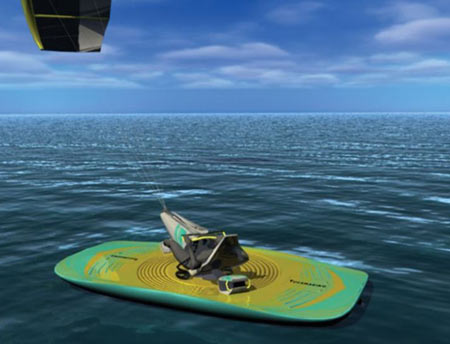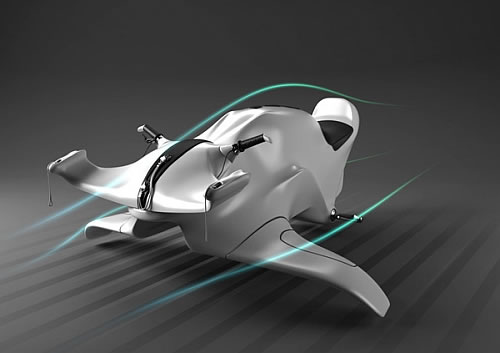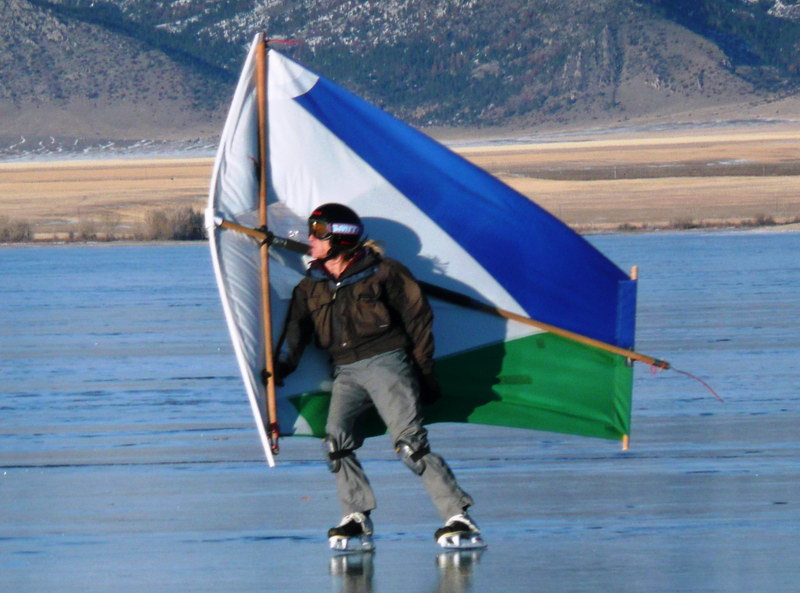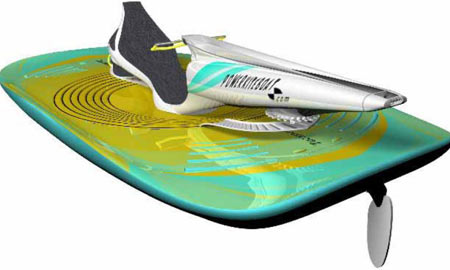Source(google.com.pk)
Kite Sailing Biography
The World of Kite Sailing
With rapidly growing popularity, kite-sailing (or kite-surfing) has won over former windsurfers and quickly become the successor to that sect of the sport.
Wind junkies beware, there is a new sailing discipline out there that might just force your wallet open, rearrange your life's priorities, and produce a little friction on the homefront. But don't worry, those few nights you might have to spend on the couch will be worth it, I can assure you. Kite-sailing (or kite-surfing) has arrived on the scene and is causing quite a disturbance in the households of windsurfers, wakeboarders, and small-boat sailors alike.
Because they use a large kite to harness the wind, kite-surfers can enjoy the rush of speed sailing, the freedom of wakeboarding without a boat, and the ability to fly higher than any wind-surfer has dreamed of jumping. And because these kites fly well above the water, they're less subject to the inter-medium friction that bedevils boats and windsurfers. But that's not the only plus. Due to their small size, the kites (when packed) and the relatively small boards are really convenient as onboard toys. And kite sailors can travel with their rigs by air without any additional baggage charges.
So you're asking, ‘What in the world is this guy talking about?' Let's start with a little history: Domina Jalbert created the first ram-air-induced kite in 1964. This invention allowed a person to steer a kite in a controllable manner with the air channels in the kite offering stability and shape while in flight. Years later in 1982, Corey Rosseler and his father took the next step toward kite-surfing by developing a Delta wing kite. They learned how to harness the power of the kite so as to power them over the water while on water skis.
An experienced kite-sailor delights in the joys of getting good rides in less than 10 knots of wind.
In its infancy, this sub-sect of the sport had plenty of problems that hindered the average watersports enthusiast from joining in the fun. First, the main issue was how to make the kites safe for beginners. Early kite sailors just didn't let go, and if that meant being dragged across the paved road next to the lake, well then they just went ahead and suffered the road rash or settled for spending the rest of the day chasing their kites. But soon enough a leash system was invented so that when the user let go of the bar, the kite would simply flatten out in the wind and gently fall back to earth. This small step was actually a huge development that allowed a more mainstream group of people to enter the sport.
The second issue was designing a kite and board combination that would allow a person to travel upwind so that a user could take off from a spot and not have to have a shuttle car or boat set up five miles downwind. Water skis initially offered plenty of edge control, but not enough floatation in light air and they were difficult to control when trying to head upwind. So directional surfboards became the next step and then eventually wake-boards evolved to become the platform of choice for kite sailors.
The third and final issue was figuring out how to make the kites re-launchable from the water. In 1984, Bruno and Dominique Legaignoux invented an inflatable, elliptical kite that if allowed to crash into the water, would stay on the surface and could be relaunched into the air with little effort. From that point on, advances in kite-sailing (or surfing) technology arrived as quickly as the masses of people joining the fun.
With this explosion came manufacturers, and not surprisingly, quite a few of the new entries into the kite sailing market are windsurfing companies that are making the crossover from a dwindling industry that has been suffering a loss of profits for some time. Names like Naish, Cabrinha, North, Roberto Ricci Designs (RRD) are just a few of the windsurfing big guns that are making the switch.
Part of the popularity of kite-sailing is derived from the fact that setting up is fairly easy and straightforward.
So how does a conventional sailor get started? We'll if you remember how difficult it was to get that first ride aboard a windsurfer, you'll realize that knowing a few important aspects about this new discipline can truly help accelerate your rate of learning. The first thing to do is find an instructional video. Most kite dealers will have a few to choose from, but one video recommended across the board is Boost. It is made up of two volumes. The first volume is the important one for beginners and will be a valuable resource when questions arise. The other tool when learning is a trainer kite. A smaller version of the real deal, trainer kites are the best way for a beginner to learn how a kite relates to the wind and how to control it. Once you master the trainer kite, you're ready to move up to flying the big rigs.
No matter where you're located or what watersports background you have, kite sailing is fun, but unusual enough to present a steep challenge for the beginner. The good news is that the learning curve is nearly vertical, so it won't take too long before you are up and riding. With some information and proper instruction, most beginners are up feeling comfortable after a few lessons. The sport does have its dangers and these should not be taken lightly. But once a person learns from a qualified instructor, the hazards are easy to avoid and the fun is just around the corner.
Should you find yourself interested, shopping for your first kite is where things start to get a little confusing. Basically there are two main types of kites on the market today. There are ram-air kites and what have been nicknamed inflatable kites. Both styles, when combined with a board will cost you—take a deep breath—around $2,000. There are some less expensive packages showing up on the Internet, and used gear is available as well, but be very careful when looking at either. Cheap packages tend to be made up of crappy gear that will break and cause more trouble than it is worth and used gear needs to be looked over with a fine tooth comb. Bladders in the inflatable kites can leak, control lines can be worn and just waiting to snap, along with many other issues. This is one sport where biting the bullet to buy new gear is really worth it, and the warranty you get could save you some heartbreak in the long run.
Inflatable kites like this one are best for beginners because they're the most stable.
Ram-air kites are basically rectangular kites that allow air to flow into chambers and inflate, thus giving the kite its shape and rigidity, allowing it to perform. The advantages of ram-air kites are that they're extremely maneuverable, and due to their flat design, have more power per square meter than their inflatable siblings. This difference in size makes them easier to pack, and setup time is often shorter than with an inflatable. The disadvantages include the fact that many are difficult to water start, they need to be launched directly in the power zone (downwind of the sailor) and the sensitivity of control that is a plus for experienced users is a hindrance for beginners. Many of the new ram-air designs have found solutions for some of the above problems, but it seems that many kite-surfers are choosing inflatables for their first kite.
The biggest advantage to an inflatable kite is the fact that air bladders make this kind of kite easier to water launch. Another plus is that if the pilot crashes the kite, and for some reason cannot get the kite back in the air, the bladders also provides floatation in case the user has to paddle the rig to shore for whatever reason. Inflatable kites are launched close to the neutral zone, (almost perpendicular to the wind direction), thus making them more controllable when self-launching. Lastly, inflatable kites tend to be more stable in the air and turn more slowly, therefore beginners can worry a little less about driving the kite and more about controlling the board as they speed across the top of the water. Although slightly larger than ram-air kites when they are packed, inflatable kites still take up very little space.
Inflatable kites are by far the more popular of the two. But should you choose to purchase an inflatable there is more information you'll need to know. There are different types of inflatable kites on the market. The first type is called two-line. Yep, you guessed it, the kite is controlled by two lines. These kites are remarkably simple to set up, very easy to water-launch, but when flown are fixed in a fully powered angle to the wind. So if the wind gusts, you are going to feel it and have to compensate. The other type of kite is called a four-line kite. The kite is actually still only controlled by two lines, but the other two allow these kites to be de-tuned. For experienced sailors that means the kite can be sheeted in or out so gusts of wind can be compensated for and the kite can be flown in a wider wind range. The disadvantages of a four-line kite are that they are more difficult to set up and they have a tendency to be harder to water-launch.
Step 1—get the kite flying. Step 2—walk over to the water. Step 3—get on your board. Step 4—you're kite-sailing.
If you decide to follow the trend and get into kite sailing, another thing you'll want to know about is the idea of aspect ratio. In a vast oversimplification, aspect ratio refers to the shape of the kite and specifically the curve from end to end and width. A kite with low aspect ratio, such as a typical two-line kite, tends to be wider and shorter in length with less curve from end to end. A low-aspect kite will turn more slowly through the wind, but will remain more stable with lots of power. High-aspect-ratio kites are longer and thinner, with more curve to the leading edge. These kites are designed to turn faster and offer better control. Most dedicated four-line kites offer a higher aspect ratio.
Like the T-shirt says, "kite-surfing is the wrong sport for 90 percent of the population." But for those 10 percent, hang on to your britches, because it is one hell-raising good time. Just remember that this is one sport you don't just want to jump into without taking the time to complete the introductory steps that will make it safe. Good luck and see you on the water.






















Kite Sailing Biography
The World of Kite Sailing
With rapidly growing popularity, kite-sailing (or kite-surfing) has won over former windsurfers and quickly become the successor to that sect of the sport.
Wind junkies beware, there is a new sailing discipline out there that might just force your wallet open, rearrange your life's priorities, and produce a little friction on the homefront. But don't worry, those few nights you might have to spend on the couch will be worth it, I can assure you. Kite-sailing (or kite-surfing) has arrived on the scene and is causing quite a disturbance in the households of windsurfers, wakeboarders, and small-boat sailors alike.
Because they use a large kite to harness the wind, kite-surfers can enjoy the rush of speed sailing, the freedom of wakeboarding without a boat, and the ability to fly higher than any wind-surfer has dreamed of jumping. And because these kites fly well above the water, they're less subject to the inter-medium friction that bedevils boats and windsurfers. But that's not the only plus. Due to their small size, the kites (when packed) and the relatively small boards are really convenient as onboard toys. And kite sailors can travel with their rigs by air without any additional baggage charges.
So you're asking, ‘What in the world is this guy talking about?' Let's start with a little history: Domina Jalbert created the first ram-air-induced kite in 1964. This invention allowed a person to steer a kite in a controllable manner with the air channels in the kite offering stability and shape while in flight. Years later in 1982, Corey Rosseler and his father took the next step toward kite-surfing by developing a Delta wing kite. They learned how to harness the power of the kite so as to power them over the water while on water skis.
An experienced kite-sailor delights in the joys of getting good rides in less than 10 knots of wind.
In its infancy, this sub-sect of the sport had plenty of problems that hindered the average watersports enthusiast from joining in the fun. First, the main issue was how to make the kites safe for beginners. Early kite sailors just didn't let go, and if that meant being dragged across the paved road next to the lake, well then they just went ahead and suffered the road rash or settled for spending the rest of the day chasing their kites. But soon enough a leash system was invented so that when the user let go of the bar, the kite would simply flatten out in the wind and gently fall back to earth. This small step was actually a huge development that allowed a more mainstream group of people to enter the sport.
The second issue was designing a kite and board combination that would allow a person to travel upwind so that a user could take off from a spot and not have to have a shuttle car or boat set up five miles downwind. Water skis initially offered plenty of edge control, but not enough floatation in light air and they were difficult to control when trying to head upwind. So directional surfboards became the next step and then eventually wake-boards evolved to become the platform of choice for kite sailors.
The third and final issue was figuring out how to make the kites re-launchable from the water. In 1984, Bruno and Dominique Legaignoux invented an inflatable, elliptical kite that if allowed to crash into the water, would stay on the surface and could be relaunched into the air with little effort. From that point on, advances in kite-sailing (or surfing) technology arrived as quickly as the masses of people joining the fun.
With this explosion came manufacturers, and not surprisingly, quite a few of the new entries into the kite sailing market are windsurfing companies that are making the crossover from a dwindling industry that has been suffering a loss of profits for some time. Names like Naish, Cabrinha, North, Roberto Ricci Designs (RRD) are just a few of the windsurfing big guns that are making the switch.
Part of the popularity of kite-sailing is derived from the fact that setting up is fairly easy and straightforward.
So how does a conventional sailor get started? We'll if you remember how difficult it was to get that first ride aboard a windsurfer, you'll realize that knowing a few important aspects about this new discipline can truly help accelerate your rate of learning. The first thing to do is find an instructional video. Most kite dealers will have a few to choose from, but one video recommended across the board is Boost. It is made up of two volumes. The first volume is the important one for beginners and will be a valuable resource when questions arise. The other tool when learning is a trainer kite. A smaller version of the real deal, trainer kites are the best way for a beginner to learn how a kite relates to the wind and how to control it. Once you master the trainer kite, you're ready to move up to flying the big rigs.
No matter where you're located or what watersports background you have, kite sailing is fun, but unusual enough to present a steep challenge for the beginner. The good news is that the learning curve is nearly vertical, so it won't take too long before you are up and riding. With some information and proper instruction, most beginners are up feeling comfortable after a few lessons. The sport does have its dangers and these should not be taken lightly. But once a person learns from a qualified instructor, the hazards are easy to avoid and the fun is just around the corner.
Should you find yourself interested, shopping for your first kite is where things start to get a little confusing. Basically there are two main types of kites on the market today. There are ram-air kites and what have been nicknamed inflatable kites. Both styles, when combined with a board will cost you—take a deep breath—around $2,000. There are some less expensive packages showing up on the Internet, and used gear is available as well, but be very careful when looking at either. Cheap packages tend to be made up of crappy gear that will break and cause more trouble than it is worth and used gear needs to be looked over with a fine tooth comb. Bladders in the inflatable kites can leak, control lines can be worn and just waiting to snap, along with many other issues. This is one sport where biting the bullet to buy new gear is really worth it, and the warranty you get could save you some heartbreak in the long run.
Inflatable kites like this one are best for beginners because they're the most stable.
Ram-air kites are basically rectangular kites that allow air to flow into chambers and inflate, thus giving the kite its shape and rigidity, allowing it to perform. The advantages of ram-air kites are that they're extremely maneuverable, and due to their flat design, have more power per square meter than their inflatable siblings. This difference in size makes them easier to pack, and setup time is often shorter than with an inflatable. The disadvantages include the fact that many are difficult to water start, they need to be launched directly in the power zone (downwind of the sailor) and the sensitivity of control that is a plus for experienced users is a hindrance for beginners. Many of the new ram-air designs have found solutions for some of the above problems, but it seems that many kite-surfers are choosing inflatables for their first kite.
The biggest advantage to an inflatable kite is the fact that air bladders make this kind of kite easier to water launch. Another plus is that if the pilot crashes the kite, and for some reason cannot get the kite back in the air, the bladders also provides floatation in case the user has to paddle the rig to shore for whatever reason. Inflatable kites are launched close to the neutral zone, (almost perpendicular to the wind direction), thus making them more controllable when self-launching. Lastly, inflatable kites tend to be more stable in the air and turn more slowly, therefore beginners can worry a little less about driving the kite and more about controlling the board as they speed across the top of the water. Although slightly larger than ram-air kites when they are packed, inflatable kites still take up very little space.
Inflatable kites are by far the more popular of the two. But should you choose to purchase an inflatable there is more information you'll need to know. There are different types of inflatable kites on the market. The first type is called two-line. Yep, you guessed it, the kite is controlled by two lines. These kites are remarkably simple to set up, very easy to water-launch, but when flown are fixed in a fully powered angle to the wind. So if the wind gusts, you are going to feel it and have to compensate. The other type of kite is called a four-line kite. The kite is actually still only controlled by two lines, but the other two allow these kites to be de-tuned. For experienced sailors that means the kite can be sheeted in or out so gusts of wind can be compensated for and the kite can be flown in a wider wind range. The disadvantages of a four-line kite are that they are more difficult to set up and they have a tendency to be harder to water-launch.
Step 1—get the kite flying. Step 2—walk over to the water. Step 3—get on your board. Step 4—you're kite-sailing.
If you decide to follow the trend and get into kite sailing, another thing you'll want to know about is the idea of aspect ratio. In a vast oversimplification, aspect ratio refers to the shape of the kite and specifically the curve from end to end and width. A kite with low aspect ratio, such as a typical two-line kite, tends to be wider and shorter in length with less curve from end to end. A low-aspect kite will turn more slowly through the wind, but will remain more stable with lots of power. High-aspect-ratio kites are longer and thinner, with more curve to the leading edge. These kites are designed to turn faster and offer better control. Most dedicated four-line kites offer a higher aspect ratio.
Like the T-shirt says, "kite-surfing is the wrong sport for 90 percent of the population." But for those 10 percent, hang on to your britches, because it is one hell-raising good time. Just remember that this is one sport you don't just want to jump into without taking the time to complete the introductory steps that will make it safe. Good luck and see you on the water.
Kite Sailing

Kite Sailing

Kite Sailing

Kite Sailing
Kite Sailing

Kite Sailing

Kite Sailing

Kite Sailing
Kite Sailing

Kite Sailing

Kite Sailing

Kite Sailing

Kite Sailing

Kite Sailing

Kite Sailing

Kite Sailing

Kite Sailing

Kite Sailing
Kite Sailing

Kite Sailing

Kite Sailing

Kite Sailing

Kite Sailing
No comments:
Post a Comment